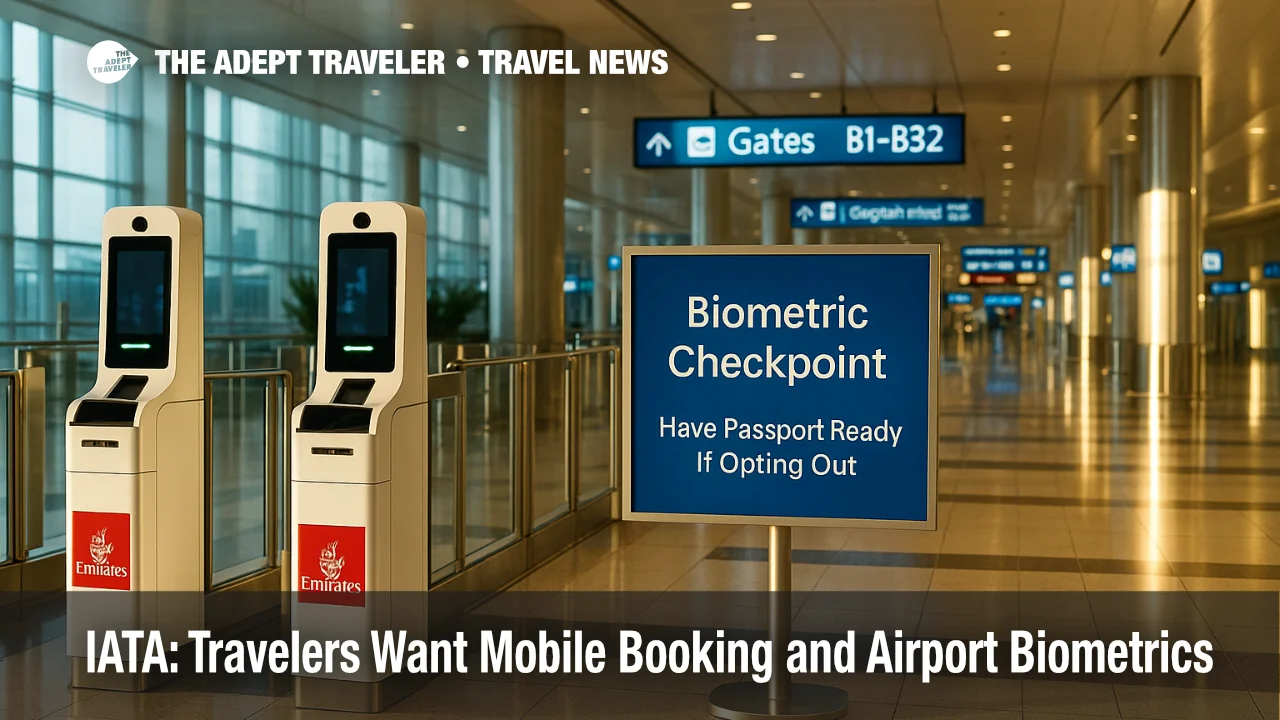IATA: Travelers Want Mobile Booking and Airport Biometrics

Key points
- IATA's 2025 survey shows strong demand for smartphone booking, payment, and wayfinding
- Half of passengers used biometrics this year and 85 percent were satisfied with the experience
- Seventy four percent would share biometrics to skip passport or boarding pass checks
- TSA confirms U.S. facial recognition remains optional with a manual alternative available
- Emirates expands a passport free biometric path across Dubai International Airport
Impact
- Booking & Payment
- Use airline apps and digital wallets to streamline reservations and receipts
- Airport Time Savings
- Enroll in airline or airport biometric programs where available to shorten touchpoints
- Privacy Choices
- If you prefer not to use facial recognition in the U.S., tell the officer and use the manual process
- International Readiness
- Expect more digital ID trials and begin renewing passports early to link profiles cleanly
- Family Travel
- Confirm how biometrics apply to children and bring physical documents as a backup
More travelers are managing flights from the palm of their hand and moving faster through airports with face-match ID. The International Air Transport Association's 2025 Global Passenger Survey points to a decisive shift toward mobile everything, with most respondents saying they want to book, pay, and navigate using a smartphone. Biometric use is also rising worldwide, and satisfaction with it is high, even as privacy choices remain important. For U.S. travelers, facial recognition is optional, and a manual check is always available. The direction of travel is clear, however, as large hubs add end-to-end biometric corridors.
IATA's 2025 snapshot
IATA reports that passengers increasingly prefer to complete the journey on mobile and with a digital identity. This year's findings include strong support for smartphone booking and payment, and a willingness to use digital ID to speed checkpoints. IATA highlights that 74 percent of travelers are open to sharing biometric data if it replaces repeated document checks at steps like check-in, security, border control, and boarding. Half of passengers used biometrics somewhere in their journey this year, and 85 percent reported being satisfied with the experience, signaling that real-world trials are meeting expectations.
The survey also captures a steady climb in mobile-enabled self-service, such as generating baggage tags during check-in and using digital wallets for payment. These behaviors tie into a broader push to make travel fully digital, an area where IATA's Digital Identity initiative is working with governments and industry to enable secure, interoperable credentials.
Latest developments
On November 4, Emirates described a major expansion of facial recognition across Dubai International Airport (DXB). Registered customers can move from check-in to immigration, lounges, and boarding without showing a passport or boarding pass, with cameras recognizing a traveler's profile from about a meter away. The project, developed with Dubai's identity and residency authorities, aims to reduce processing time and congestion at peak periods.
Analysis
For travelers, the practical upside is speed. If your airline, airport, or lane supports biometrics, you can often replace multiple stop-and-show moments with a single face-match as you walk. That benefit compounds during banked departures and tight connections. The tradeoffs are familiar: you are consenting to a biometric capture and match, and you need to understand who holds the template, how long it is retained, and how it is protected.
In the United States, the baseline control remains with the traveler. The Transportation Security Administration's guidance is explicit that the facial comparison technology at checkpoints is optional. If you do not wish to participate, you can notify the officer and proceed with a standard ID check without losing your place. This keeps the convenience path available while preserving a no-biometric alternative for those who prefer it.
Background Digital identity replaces repeated document presentation with a verified credential that can be shared securely with an airline or border authority. IATA and partners are building standards so a credential issued in one country can be recognized in another, which would allow a truly paper-light journey in the future. Until governments issue digital passports widely and harmonize recognition, travelers should expect a hybrid world where mobile credentials and physical documents coexist.
Policy debates will continue, particularly around data security and civil liberties. Recent industry letters and legislative proposals in Washington show that facial recognition remains a live topic, balancing throughput gains against privacy risk. For now, the operational reality is incremental rollout with opt-in lanes, clear signage, and parallel manual processes.
Final thoughts
Mobile booking and airport biometrics are moving from pilot to practice. IATA's 2025 results, paired with deployments like Emirates at Dubai International, point to a future where your phone and verified face carry most of the journey. Keep your options open, know your privacy choices, and use biometrics when the time savings help your itinerary.
Sources
- IATA's 2025 Global Passenger Survey Reveals Mobile and Biometrics Momentum
- Powering the Future of Contactless Travel
- Digital Identity Program
- Facial Comparison Technology, TSA Factsheet
- Digital Identity and Facial Comparison Technology, TSA
- Emirates Invests in Innovative Facial Recognition Across Dubai International (DXB)
- Emirates Brings Facial Recognition Initiative to Dubai International Airport
